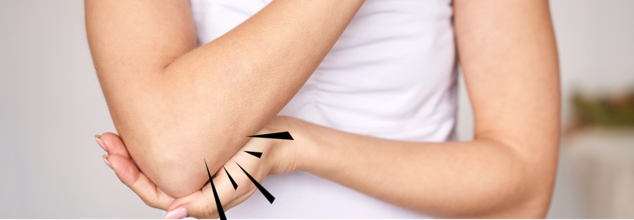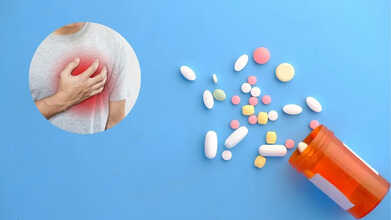- Health Conditions A-Z
- Health & Wellness
- Nutrition
- Fitness
- Health News
- Ayurveda
- Videos
- Medicine A-Z
- Parenting
- Web Stories
What That Popping Sound In Your Joints Really Mean

If you've ever heard your knees pop when you stand up or noticed a cracking sound in your back as you stretch, you’re not alone. These sounds, medically known as crepitus, are common and usually harmless. But what exactly causes them? And when should you be concerned?
Joints are the points where two bones meet, and their movement can sometimes create various noises. While occasional popping is normal, persistent or painful joint sounds may signal underlying issues that require attention.
What Causes Your Joints to Crack and Pop?
There are several reasons why joints make noise, ranging from harmless gas bubbles to more serious joint conditions. Understanding the cause behind these sounds can help you determine whether it’s a normal occurrence or something that warrants medical evaluation.
1. Gas Bubbles Escaping
One of the most common reasons for joint cracking is the release of gas bubbles within the synovial fluid, which lubricates the joints. This fluid contains dissolved gases like oxygen, nitrogen, and carbon dioxide. When the joint moves, these gases can form bubbles and then collapse, producing a popping sound. This process is completely normal and does not indicate any damage to the joint.
2. Ligament and Tendon Movement
Tendons and ligaments are the connective tissues that support your joints and enable movement. Sometimes, they can stretch over a bone and then snap back into place, causing a popping or clicking sound. This often happens in the knees, ankles, and shoulders, especially during physical activities like running or weightlifting.
3. Cartilage Wear and Tear
Cartilage acts as a cushion between bones, preventing friction during movement. Over time, due to aging or excessive strain, this cartilage can wear down, leading to increased joint noises. As bones begin to make more contact, you may hear grinding or grating sounds, which could indicate early osteoarthritis.
4. Tight Muscles and Tendons
If your muscles or tendons are tight, especially after prolonged inactivity or intense exercise, they may produce soft clicking or snapping noises when they glide over bony structures. This is common in individuals who perform repetitive movements or those with limited flexibility.
When Should You Be Concerned About Joint Cracking?
While most joint noises are harmless, there are some situations where popping and cracking could be a sign of an underlying medical issue. Pay attention to the following symptoms:
Pain and Swelling: If cracking is accompanied by pain, swelling, or limited movement, it could indicate conditions like bursitis, ligament injuries, or osteoarthritis.
Persistent or Loud Cracks: A single loud crack followed by pain or instability may be a sign of a ligament tear, such as an anterior cruciate ligament (ACL) injury.
Popping with Locking or Stiffness: If your joints pop and then feel stuck or difficult to move, it might be due to meniscus tears or plica syndrome, conditions affecting knee joint function.
Sudden Onset After Injury: If joint noises begin suddenly following an injury, such as a fall or sports-related impact, it is best to seek medical attention to rule out fractures or dislocations.
Does Cracking Your Joints Lead to Arthritis?
A long-standing myth suggests that cracking your knuckles or other joints can cause arthritis. However, there is no scientific evidence to support this claim. Studies have found no direct link between joint cracking and arthritis development. That said, excessive cracking may lead to minor issues like reduced grip strength or mild swelling over time, but it is not a cause of arthritis.
How to Reduce or Prevent Joint Noises
If you want to minimize joint popping, incorporating movement and strengthening exercises into your routine can help. Here are some effective strategies:
1. Keep Moving
Regular physical activity helps maintain joint health and flexibility. Low-impact exercises like swimming, walking, and cycling can reduce stiffness and enhance joint function.
2. Stretching and Strength Training
Stretching tight muscles and tendons can prevent excessive joint noises. Strength training also supports the muscles surrounding the joints, reducing stress on them.
3. Maintain a Healthy Weight
Excess weight places additional stress on weight-bearing joints like the knees and hips. Maintaining a balanced diet and engaging in regular exercise can alleviate pressure and reduce wear and tear.
4. Proper Warm-Up and Cool-Down
Warming up before exercise and cooling down afterward can prevent sudden stress on the joints and muscles, reducing the likelihood of popping sounds.
5. Hydration and Nutrition
Staying hydrated and consuming joint-friendly nutrients like omega-3 fatty acids, vitamin D, and collagen can support cartilage health and joint lubrication.
Are There Any Treatments for Joint Cracking?
If joint noises become problematic or painful, a healthcare provider may recommend one or more of the following treatments:
Physical Therapy: Strengthening exercises and mobility training can help stabilize joints and reduce discomfort.
Bracing or Support Devices: For conditions like osteoarthritis, wearing braces or supportive footwear can minimize joint stress.
Medication: Anti-inflammatory medications may be prescribed for painful joint conditions.
Surgery: In severe cases, procedures like arthroscopy may be necessary to repair damaged cartilage or ligaments.
Should You See a Doctor For Cracking Joints?
Joint noises are generally not a cause for concern. However, if popping sounds are accompanied by pain, swelling, or stiffness, it's best to consult a healthcare provider. Early intervention can prevent further joint deterioration and improve overall mobility.
Joint cracking and popping are often normal and result from gas release, tendon movement, or minor friction. However, persistent or painful joint sounds may indicate underlying health conditions like arthritis or ligament injuries.
Common Painkiller Tramadol Found Ineffective For Chronic Pain, May Trigger THIS Serious Health Risk

Credits: Canva
Tramadol, a strong synthetic opioid, has been commonly prescribed for moderate to severe pain. However, a recent study suggests that its risks may outweigh its modest benefits for chronic pain, and its use should be carefully reconsidered. Published in the journal BMJ Evidence-Based Medicine, the study found that tramadol may offer only a slight reduction in chronic pain, with limited evidence supporting its effectiveness.
More worryingly, it could contribute to long-term health problems that might become life-threatening. Let’s examine the study’s findings in detail.
What Is Tramadol Used For?
Tramadol is a prescription, only synthetic opioid used to manage moderate to severe pain. It works by changing how the brain and nervous system perceive pain, according to Medline Plus. Its uses include:
- Acute pain: Immediate-release formulations help manage short-term, intense pain, such as after surgery or an injury.
- Chronic pain: Extended-release tablets and capsules are used for persistent, severe pain when other treatments have failed.
- Condition-specific pain: It may be prescribed for ongoing pain from conditions such as osteoarthritis, fibromyalgia, and neuropathic pain.
Tramadol Can Lead To Serious Health Issues?
A new review suggests that millions of Americans with chronic pain may be prescribed tramadol, a drug that may provide minimal relief. Even more concerning, the research highlights that the medication could increase the risk of serious health complications, including heart disease, the leading cause of death in the US.
According to the Centers for Disease Control and Prevention, about 51.6 million adults in the US, roughly one in five, experience chronic pain, with 17.1 million having pain that interferes with daily life or work. Tramadol has often been used to manage this pain, with 16 million prescriptions written for the drug in 2023 alone. Traditionally seen as a “safer alternative” to stronger opioids, tramadol has been perceived to carry fewer side effects and a lower risk of addiction.
Given conflicting evidence from earlier limited studies, Danish researchers decided to evaluate whether tramadol is truly effective and safe for chronic pain. “The findings suggest that the benefits of tramadol are questionable or uncertain. Additionally, there is evidence of potentially harmful effects,” said Dr. Janus Jakobsen, lead author and clinical professor at the University of Southern Denmark.
Tramadol Side Effects
Tramadol can cause serious side effects, including heart-related issues such as chest pain, heart disease, or congestive heart failure. The study also found it increased the risk of both mild and serious adverse events, including nausea, dizziness, constipation, drowsiness, and cardiac complications. It may also be linked to neoplasm events, abnormal cell growths that can lead to tumors, which may be benign or malignant.
These findings, published in BMJ Evidence-Based Medicine, arrive amid the ongoing opioid crisis in the US, which has claimed hundreds of thousands of lives since the late 1990s. Research indicates that around 12% of patients treated with opioids for chronic pain may develop addiction or misuse the drugs, raising the risk of overdose and other severe outcomes.
The opioid epidemic was declared a national public health emergency by President Trump in 2017, and the death toll has continued to rise in the years since.
10 Sleep Truth That May Be Holding You Back From Proper Rest, Sleep Doctor Reveal Harsh Sleep Truths

(Credit-Canva)
A major part of your health depends on your sleep. While you may delay your sleep or skip it to do other tasks, your body keeps the score. You may be slowly pushing yourself into not just physical health issues, but also mental health issues.
While sleep may seem like an easy thing, you only need enough time for there are many aspects of it that could reveal whether you are sleeping well or not. In a recent post, Dr Christopher J Allen, MD, a US board-certified sleep doctor, revealed 10 important sleep facts that one must know.
Sleep Advice You Need For Proper Rest
In the video titled, “Advice I’d give you as a sleep doctor for a decade – If I wasn’t afraid of hurting your feelings” he gave the below mentioned advice.
Snoozing Doesn't Help
Hitting the snooze button actually confuses your brain. It starts a new sleep cycle that you immediately interrupt. This guarantees you will feel more groggy and tired all morning, not rested. Just get up when the alarm first rings.
Late-Night Energy Isn't Natural
Feeling "wired" late at night isn't natural energy. It usually means you've had too much stimulation, you're dehydrated, and you're stuck in a constant stress cycle. Your body is running on high alert, not true fuel.
Instant Sleep Isn't Healthy
If you fall asleep the second your head hits the pillow, you don't have great sleep; you have a problem. It's a clear sign of severe exhaustion or a major sleep debt built up from missing sleep over time.
You Need Recovery, Not Stimulants
Your constant low energy can't be fixed by simply drinking more caffeine. Your real issue is a lack of proper recovery. You need more REM sleep—the deep, restorative kind—to truly solve your energy problem.
Midnight Waking Is Stress-Related
Waking up sharply at 3 AM is not random bad luck. It often happens because your stress hormones, called cortisol, start pumping during the night. Your body is on high alert, starting its "night shift" while you should be resting.
Scrolling Isn't Relaxing
You think you're relaxing when you scroll through your phone, but your nervous system disagrees. The bright screen and constant stimulation signal danger to your brain, putting you into survival mode instead of calming you down.
Weekend Catch-Up Doesn't Work
Trying to "catch up" on sleep during the weekend doesn't fix your sleep debt. It simply throws off your body's internal clock (circadian rhythm). This actually makes it much harder to wake up and start your week on Monday.
You Can't 'Get Used To' 5 Hours
Science shows that believing you are "used to" only five hours of sleep is dangerous. Your body is actually quietly suffering damage and breaking down. You need more sleep to avoid long-term health risks.
Tiredness Starts Before Bed
Waking up feeling completely exhausted isn't usually your mattress's fault. It’s often connected to your stress mindset, the food you eat, and those sneaky stress hormone spikes that happen while you should be deeply sleeping.
Most Important Factor For Sleep
The health expert ended the post by explaining your body can't truly heal and recover if you keep it in the same environment and under the same stress that makes you feel run down. Your bedroom and your nightly routine are actually a direct reflection of your entire lifestyle.
The core scientific truth is that your body isn't being lazy, it is genuinely exhausted, and your brain isn't broken, it's just begging for the safety and security that comes from good, proper rest.
Feeling Anxious Lately? Experts Reveal How It Might Be Affecting Your Blood Pressure

Credits: Canva
According to India’s National Mental Health Survey, nearly 3.5% of the country’s population experiences anxiety disorders each year, often triggered by work stress, relationship problems, or distressing events. While mild anxiety is a normal part of life, persistent or unmanaged anxiety can keep older adults in a constant state of tension.
This long-term stress may increase heart rate, affect mood, and, as experts now warn, even raise blood pressure (BP). The American Psychological Association (APA) defines anxiety as ongoing feelings of worry or unease that can cause physical reactions such as a faster heartbeat or sweating.
The APA also notes that anxiety can temporarily elevate blood pressure. In turn, people with chronic high blood pressure, or hypertension, may develop anxiety about their health, creating a cycle where each condition worsens the other.
Can Anxiety Lead To Blood Pressure?
Anxiety is the body’s built-in response to stress. It’s common to feel anxious before a major exam or while awaiting important news. When this happens, the body releases stress hormones that raise the heart rate and narrow blood vessels, both of which can push blood pressure higher.
A 2015 study by Medical News Today found that individuals with severe anxiety faced a greater risk of developing hypertension compared to those with milder symptoms. Researchers emphasized the importance of early diagnosis and treatment of anxiety, especially for people who already have high blood pressure.
In most cases, anxiety-related spikes in blood pressure are short-lived and return to normal once the person calms down. However, constant anxiety can strain the heart, kidneys, and blood vessels much like long-term hypertension does. Over time, hormonal changes linked to anxiety may lead to fat accumulation, especially around the waist. Anxiety can also alter daily habits, such as causing stress eating, which may indirectly raise blood pressure.
Signs of Anxiety-Induced High Blood Pressure
A normal blood pressure reading typically falls between 90/60 mmHg and 120/80 mmHg. For adults over 80, readings below 150/90 mmHg are considered healthy. When readings consistently rise above these levels, it can indicate hypertension. Some anxiety medications can also increase blood pressure. For example, serotonin and noradrenaline reuptake inhibitors (SNRIs), commonly used to treat anxiety disorders, are known to cause a rise in BP. Common symptoms of anxiety that may contribute to higher blood pressure include:
- Trembling or shaking
- Excessive sweating
- Chest pain
- Headaches
- Nausea or stomach discomfort
- Irritability
- Dizziness or shortness of breath
Can High Blood Pressure Also Trigger Anxiety?
High blood pressure itself can sometimes lead to feelings of anxiety. People diagnosed with hypertension may start worrying about their long-term health or potential complications. The symptoms of hypertension, such as headaches, vision problems, or an irregular heartbeat can also cause distress or panic. According to Medical News Today, signs of hypertension can include:
- Vision changes
- Headaches
- Irregular heart rhythm
- Buzzing in the ears
Severe hypertension can also provoke anxiety. If someone feels unusually anxious and experiences symptoms like headaches or shortness of breath, it is important to seek immediate medical help.
Since hypertension often develops without clear warning signs, it can be difficult to tell whether the cause of discomfort is anxiety or high blood pressure. This is why regular check-ups with a doctor are essential for monitoring and managing both conditions effectively.
© 2024 Bennett, Coleman & Company Limited

